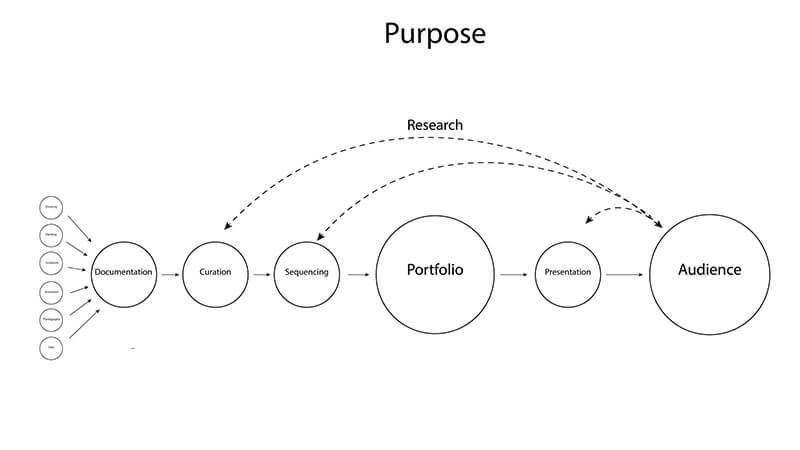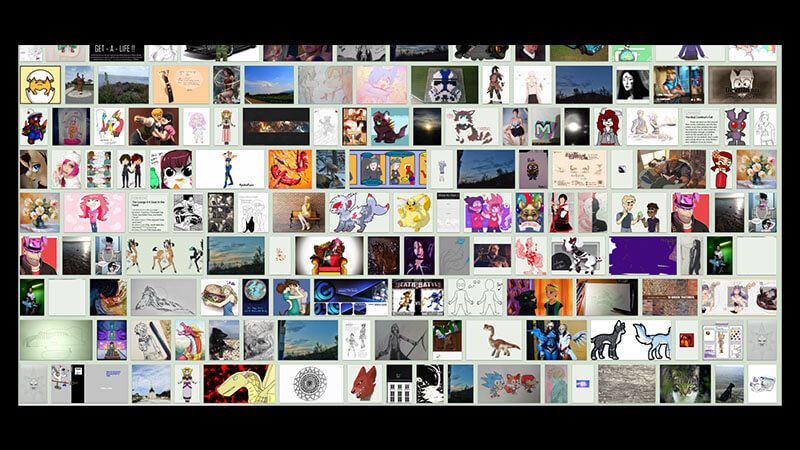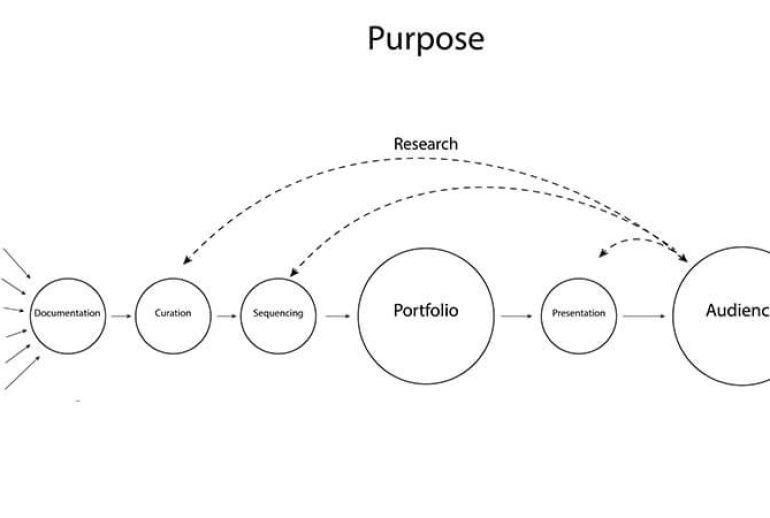Pop Quiz Hotshot!
As someone dedicated to the creation of meaningful visual stuff, what is the most important professional asset you possess?
- Your quick wit?
- Your lucky shark tooth necklace?
- Your Uncle who knows a guy?
- The Instagram photo of you eating a burrito the size of a baby that got 12,000 likes?
- Your minor in psychology?
- Your M.F.A. degree?
- Your resume/cv?
- Your creative work (paintings, photographs, architecture, etc.)?
Answers in Order
- Nope
- No
- No
- Definitely not
- Nope, not even close
- A big overpriced No
- Closer, but no
- Even closer, but still no
The Actual Answer
The single most important professional asset you possess as a visual creative is your portfolio. Period.
No matter what stage you are in your creative career, your portfolio will be the determining factor between success and failure.
Applying to an art school? Want that production job at DreamWorks? Want to sell your design services to a client? Trying to get into a gallery show?
Degrees, connections, and resumes may help but good luck competing with your fellow degree holders (and increasingly non-degree holders) with a weak and poorly designed portfolio.
This is why I am always amazed at how commonly I see creatives make the same mistakes over and over when it comes to showing their work through their portfolio. Avoid these, and you will put you and your work at a huge advantage.
Mistake #1 -Thinking a portfolio is your work.
I know this sounds counter-intuitive but it is true.
A portfolio contains your work. A portfolio cannot exist without your work, but it is not your work. It is incredibly important to differentiate between your work and your portfolio.
A portfolio is a system, “a set of elements organized in a way to achieve some function or purpose”(Meadows, 2015).
The power of approaching your portfolio as a system stems from the fact that portfolios (like all systems) become greater than the sum of their parts. Individual elements (your work) interact with one another to communicate qualities about you and your skills that transcend anything an individual piece of work can communicate.
This includes signifiers of your hard skills (technical ability, control of a medium, mastery of tools) as well as soft skills (creativity, work ethic, sense of humor).
The meaningful interactions between pieces of work can be controlled and adapted through curation and sequencing in order to communicate specific things about you and your work to an audience.

Mistake #2 – Not bothering to examine your portfolio’s purpose or audience’s needs.
If you don’t bother to understand why you are designing a portfolio or who the specific intended audience of your portfolio is (and what they are looking for), then there is no point in designing a portfolio.
One of the most common challenges I see students struggle with when I teach portfolio design is “what do I put in my portfolio and where?”
They ask this question having done no research into their audience and never really examining the purpose of the portfolio they are designing.
Before you even think of signing up for that Behance account you need to find clarity about why you are designing a portfolio (purpose), who the portfolio is for (audience), and what they are looking for (audience needs).
Be Specific
“To get jobs” or “to share my genius with the entire world” isn’t a specific enough purpose.
“I designed this portfolio with the intent of getting an interview (purpose) at xyz design firm (audience) for the open assistant designer position (audience need).” is better.
“I designed this portfolio for gallerist Josephine Banksy (audience) with the intent of being included in her upcoming group show (purpose) focused on representational postmodern bricolage waterfowl symbology (audience need).” is even better (even though it sounds like a terrible idea for a show).
Mistake #3 – Thinking your portfolio needs to be a comprehensive representation of you and your work
Every piece of work you include in your portfolio that is not communicating something specifically related to your purpose and audience’s needs diminishes its strength.
Your portfolio is not designed for you. Remember, it is designed for your audience and their needs. Don’t try to stuff every drawing you’ve done since third grade into it unless that is something that your audience specifically wants to see.
A portfolio used to apply for a Photoshop production job doesn’t need to include the storyboards from your epic short fan film about a day in the life of Rainbow Dash. It does need to include work that signifies you have the skills and experience to solve their Photoshop production needs.
If you are unclear about what your audience is looking for, don’t just put a bunch of work in and hope it connects (it usually won’t). Spend the extra time needed to get as clear as possible with what your audience is looking for and then curate based on that clarity.
Mistake #4 -Treating your portfolio like a homework assignment
Your portfolio is not something you do once and then just throw it out in the world and wait for a response (or grade). It is not something that is ever statically “right” or “wrong”. It is not something that is ever “complete”.
Don’t create a single portfolio and assume that it will be useful in every circumstance forever (it won’t).
Portfolios are not only systems but dynamic systems. This means they can and should be continually adapted to meet the needs of their defined purposes and audiences.
You should never be “working” on your portfolio. Instead, you should be focused on making work, your work, developing your voice, developing your skills and expertise. The portfolio, when you have a purpose and audience for it, will be designed using those elements.
If you ever catch yourself saying, “I need to do more observational drawing for my portfolio!” stop and re-evaluate. By all means, practice your observational drawing but do it because it is a vital skill set, not that you think it will always be needed in your portfolio.
Mistake #5 – Creating One Portfolio and Calling it a day
Now that we understand that:
- Your portfolio should be designed around a purpose and an audience’s needs.
- Your portfolio shouldn’t be a comprehensive body of all of your work.
It follows that you will be designing as many portfolios as you have purposes and audiences. Do not design one portfolio, spam it out to everyone, and expect it to achieve its purpose (it won’t).
Mistake #6 – Arbitrarily throwing things up on the internet

When you share your work online you are creating a digital portfolio whether you intend to or not. This is true even if it is simply a series of Instagram posts.
Portfolios are strong signifiers that can communicate negative things just as readily as positive things, so do not just throw up work for the sake of getting it out there.
Think about why you are posting or sharing and what it will communicate to your audience.
Social media can be a very powerful marketing and branding tool when used effectively, but it is a supplement not a replacement for an intentional, focused portfolio designed and presented for a specific purpose.
Mistake #7 – Relying on irrelevant or misplaced feedback
This mistake occurs when a creative deflects responsibility for the design of their portfolio by dumping it on a teacher, or a career counselor, or an admissions counselor at a portfolio day and asks “What should I put in my portfolio and where?”
Feedback on portfolios can be useful, but it is also very limited. This is especially true if you lack clarity about your purpose and audience.
Often, because of this lack of clarity, the conversation becomes about the work, not the portfolio. While these things are related, they are not the same thing (see Mistake #1).
What your Drawing 403 instructor thinks is strong or interesting may very well be irrelevant to the purpose of the portfolio. Why? Because your Drawing 403 instructor is not your audience.
What is worse, the feedback you get may actually work against your success if it results in curation or sequencing or presentation approaches that have nothing to do with the needs of your actual audience.
If you intend to get feedback on your portfolio then try and get it from your actual audience. If that is not possible then be absolutely sure that the person giving the feedback has a clear understanding of the portfolio’s purpose and the audience’s needs it is designed to address.
What if I do all of these things?!!!
If it seems like you check off all of the boxes in the list above don’t worry. You have what it takes to recognize and adjust things as necessary.
The vast majority of visual creatives struggle with similar stuff so every small improvement you make correcting things will put you at a huge advantage no matter what your creative intentions.
Portfolio design is an acquired skill set. You get better at it with practice, so practice it. Research your audience’s needs, think about the various purposes of your portfolios, as well as how what you create might help your audience fullfill those needs.
Then curate, sequence, and present your work in a way that communicates how you and the work you create will do just that. The more you work with your portfolio as a system the more success you will see, even if you lose your lucky shark tooth necklace.
Be well and thank you for making work that matters.
